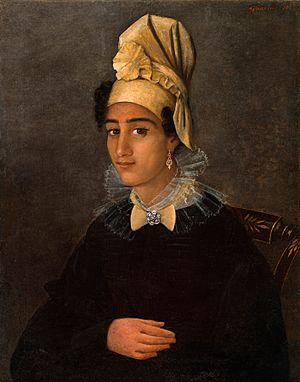Tignon law facts for kids
The tignon law was a rule made in 1786 by the Spanish Governor of Louisiana, Esteban Rodríguez Miró. This law made it mandatory for black women to wear a special headscarf called a tignon. The law's goal was to control how free black women dressed and to make them look different from white women. It also aimed to visually link them to enslaved people. However, many women who wore the tignon turned it into a beautiful "mark of distinction" instead.
Why the Law Was Made
Before the tignon law, there was a French rule called the Code Noir (which means "Black Code"). This code limited the lives of people of color in French colonies. It started in 1685 for the Caribbean islands and came to Louisiana in 1724. Spanish rulers later made similar rules.
By 1786, Esteban Rodríguez Miró was the Spanish governor of Louisiana. He felt that some black women were dressing "too luxuriously." White women in the area also pushed Governor Miró to create rules about how non-white women dressed.
What the Law Said
Governor Miró added the tignon rule to a larger order he was issuing on June 2, 1786. This order was called the bando de buen gobierno, meaning "proclamation of good government."
The rule stated that women of color had to cover their hair with a scarf or handkerchief. This was meant to be a clear sign that they belonged to the "slave class," even if they were free. It specifically said that "Negras Mulatas, y quarteronas can no longer have feathers nor jewelry in their hair. [... instead, they] must wear [their hair] plain (Ilanos) or wear panuelos, if they are of higher status, as they have been accustomed to."
How the Law Affected People
Laws that controlled what black people could wear were common in the 1700s. Governor Miró hoped the tignon law would help control the social standing of free black women. He wanted to make them look less like white women and more like enslaved people.
At first, white women in New Orleans stopped wearing their hair in similar styles. But later, Empress Joséphine of France adopted the headpiece. This made the tignon a fashionable item in the early 1800s, before it became less popular around the 1830s.
Historian Virginia Gould wrote that the real reason for the law was to control women who were becoming too successful or dressing too elegantly. These women were seen as a challenge to the social order. She also noted that there's no proof the law was strictly enforced. Instead, the women who wore the tignon often turned it into a symbol of pride and unique style.


